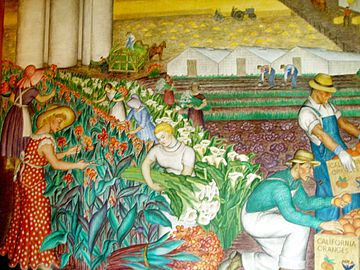“This was the first Works of Public Art (WPA) project of the 1930’s. You could say they were Beta Testing the concept of employing artists to make public art,” said Davy Crockett, Coit Tower’s tour
director.
“It was a rough time in San Francisco, before the highway system was in place, the only way, to get to San Francisco, was by boat or rail and no one was coming.” Mr. Crockett went on.
The Federal Highway bill wasn’t signed into law until 1956. Before that year, the routes to San Francisco were the same as they were in 1856 except cars had replaced covered wagons.
“Twenty-six artists, 19 assistants, and three plasterers lived and worked on site from January to the end of April 1934. It was a Bohemian atmosphere and the organizers decided chaperones were necessary. A retired General, who had served in WWI and his wife, moved into an apartment on the second floor where the office is, now.
There was a lot of political unrest due to the depression, all over the country. Economic difficulties radicalized both citizens of San Francisco and its artists. Labor unions organized workers. Within weeks of the mural’s finish, one of the largest labor strikes, crossing multiple industries, took place in San Francisco.
Artists agreed that no person would be painted smiling, anywhere in the building. One set of murals showed people playing at the beach. Originally the artist gave smiling faces to his subjects but others convinced him to remove them to keep the theme consistent and he did.
Eventually, the tower fell into disrepair. Linda, from Santa Rosa, remembers going there in the ‘80’s. “The walls were defaced with vulgar graffiti and the place smelled like urine.” She said.
“It used to leak like a sieve; hadn’t been cleaned for 25 years. We just spent $2,000,000 bringing it into the 21st Century,” said Mr. Crockett.
The murals are beautifully restored by professional artists using original materials. Upstairs, in a room that can only be been seen if you get there at 11:00 am on Saturdays, is a room of outlined paintings originally rendered with egg tempera on
plaster. It was the most difficult art to restore. Today, there is nary a crack or scrape to be found anywhere. The snapshots of working people of the time are rendered in majestic, heroic detail.
Be sure to visit Coit Tower to hear more, interesting stories.
Most visitors visit the tower at the urging of European guidebooks. Being local, neither my husband nor I had ever visited Coit Tower. No one told us it was a worthwhile trip. Now after the restoration, I’m telling you: You don’t want to miss it!
Eighty percent of the people, who visit, walk up Filbert Street from North Beach or walk up Green Street to Montgomery Street and turn left. Here are steps on each side of the dead end wall; go up these and follow the signs. Both routes involve lots of stairs, but it’s worth the effort. As you pass clean, Art Deco era homes the bay unfolds below. Both bridges, Alcatraz and Treasure Island open in a panoramic scene.
After viewing the art take the antique, but completely refurbished, elevator to the top for breathtaking views of the entire Bay Area. Think how many times and from how many places you can look up to see Coit Tower, whether you’re on a Ferry, a cable car going over Nob Hill or crossing a bridge. Coit Tower can see you, too. Go, and take your children. You’ll all be better people for it.
Coit Tower is open from 10:00 am to 6:00 pm. Go early to avoid standing in a long line. The address is 1 Telegraph Hill Blvd. at Greenwich Street. Go, already.






